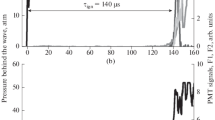Experimental investigation of the ignition of a stoichiometric hydrogen–oxygen mixture behind an incident shock wave in a shock tube at pressures p = 0.002–0.46 MPa and temperatures T = 500–1000 K is carried out. The existence of three limits of ignition typical of the ignition of hydrogen–oxygen mixtures in a spherical vessel is noted. It is shown that at pressures p ≥ 0.1 MPa the ignition of a hydrogen–oxygen mixture begins at a much lower temperature than the ignition of a hydrogen–air mixture. The measured induction times agree well with theoretical estimates.
Similar content being viewed by others
References
D. Cecere, E. Giacomazzi, and A. Ingenito, A review on hydrogen industrial aerospace applications, Int. J. Hydrogen Energy, 39, No. 20, 10731–10747 (2014).
A. A. Shekarian, S. Tabejamaat, and Y. Shoraka, Effects of incident shock wave on mixing and flame holding of hydrogen in supersonic air flow, Int. J. Hydrogen Energy, 39, No. 19, 10284–10292 (2014).
E. Schultz and J. Shepherd, Validation of detailed reaction mechanisms for detonation simulation, Tech. Report FM99-5, California Institute of Technology, Pasadena (2000).
V. A. Pavlov and G. Ya. Gerasimov, Measurement of ignition limits and induction times of hydrogen–air mixtures behind the incident shock wave front at low temperatures, J. Eng. Phys. Thermophys., 87, No. 6, 1291–1297 (2014).
M. Steinberg and W. E. Kaskan, The ignition of combustible mixtures by shock waves, Proc. Combust. Inst., 5, 664–672 (1955).
V. V. Voevodskii and R. I. Soloukhin, Concerning the mechanism and the limits of chain self-ignition of hydrogen with oxygen in shock waves, Dokl. Akad. Nauk SSSR, 154, No. 6, 1425–1428 (1964).
A. Cohen and J. Larsen, Explosive mechanism of the H2–O2 reaction near the second ignition limit, Techn. Report BRL-1386, Aberdeen Proving Ground: Ballistic Research Laboratories (1967).
B. Lewis and G. von Elbe, Combustion, Flames and Explosions of Gases, Academic Press, New York (1951).
S. P. Medvedev, G. L. Agafonov, S. V. Khomik, and B. E. Gelfand, Ignition delay in hydrogen–air and syngas–air mixtures: Experimental data interpretation via flame propagation, Combust. Flame, 157, No. 7, 1436–1438 (2010).
G. Ya. Gerasimov and O. P. Shatalov, Kinetic mechanism of combustion of hydrogen–oxygen mixtures, J. Eng. Phys. Thermophys., 86, No. 5, 987–995 (2013).
M. Kuznetsov, R. Redlinger, W. Breitung, J. Grune, A. Friedrich, and N. Ichikawa, Laminar burning velocities of hydrogen–oxygen–steam mixtures at elevated temperatures and pressures, Proc. Combust. Inst., 33, No. 1, 895–903 (2011).
M. F. G. Cremers, M. J. Remie, K. R. A. M. Schreel, and L. P. H. de Goey, Heat transfer mechanisms of laminar flames of hydrogen + oxygen, Combust. Flame, 139, Nos. 1–2, 39–51 (2004).
A. D. Snyder, J. Robertson, D. L. Zanders, and G. B. Skinner, Shock tube studies of fuel–air ignition characteristics, Tech. Report AFAPL-TR-65-93, Air Force Aero-Propulsion Laboratory, Wright-Patterson (1965).
M. W. Slack, Rate coefficient for H + O2 + M = HO2 + M evaluated from shock tube measurements of induction times, Combust. Flame, 28, No. 1, 241–249 (1977).
R. R. Craig, A shock tube study of the ignition delay of hydrogen–air mixtures near the second explosion limit, Techn. Report AFAPL-TR-66-74, Air Force Aero-Propulsion Laboratory, Wright-Patterson (1966).
E. Dzimińska and A. K. Hayashi, Auto-ignition and DDT driven by shock wave–boundary layer interaction in oxyhydrogen mixture, Int. J. Hydrogen Energy, 38, No. 10, 4185–4193 (2013).
K. P. Grogan and M. Ihme, Weak and strong ignition of hydrogen/oxygen mixtures in shock-tube systems, Proc. Combust. Inst., 35, No. 2, 2181–2189 (2015).
P. V. Kozlov, S. A. Losev, and Yu. V. Romanenko, Measurement of the induction time of the H2 + O2 reaction initiated by a shock wave in a stoichiometric mixture (2011); www.chemphys.edu.ru/media/files/2011-09-01-002.pdf.
Author information
Authors and Affiliations
Corresponding author
Additional information
Translated from Inzhenerno-Fizicheskii Zhurnal, Vol. 89, No. 3, pp. 575–579, May–June, 2016.
Rights and permissions
About this article
Cite this article
Pavlov, V.A., Gerasimov, G.Y. Ignition of Hydrogen–Oxygen Mixtures Behind the Incident Shock Wave Front. J Eng Phys Thermophy 89, 587–591 (2016). https://doi.org/10.1007/s10891-016-1415-7
Received:
Published:
Issue Date:
DOI: https://doi.org/10.1007/s10891-016-1415-7



